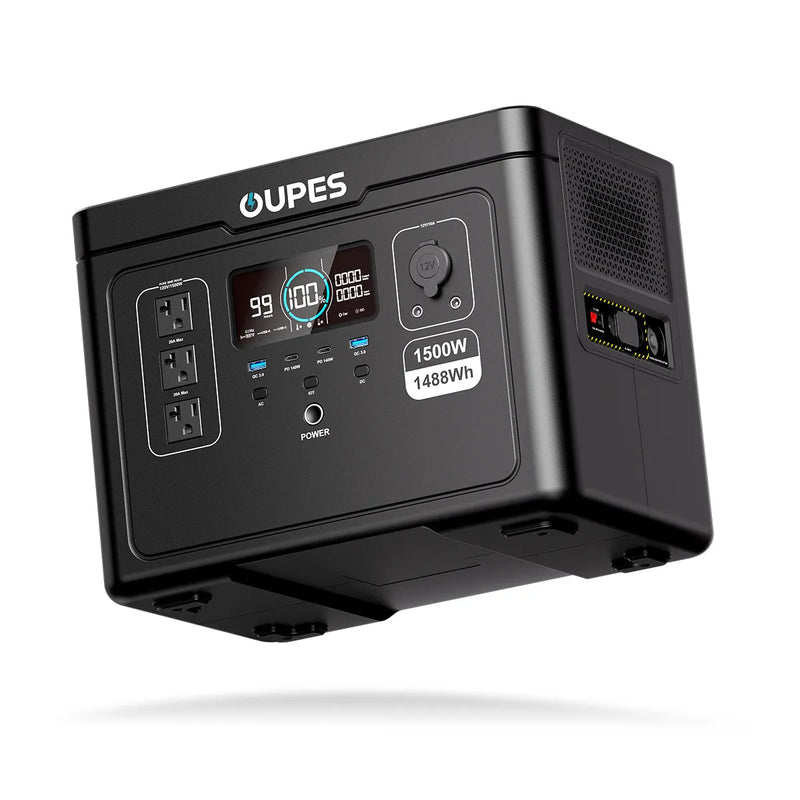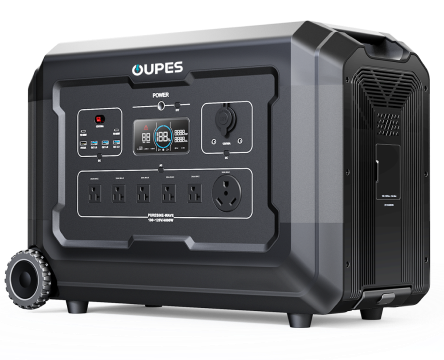
Imagine you're in the middle of a thrilling movie night or catching a crucial moment in a sports game—and then the power goes out. That’s where a power station can save the day. Whether you're prepping for emergencies, going off-grid, or camping under the stars, a portable power station gives you the flexibility to run essential electronics like your TV. But just how long can you run a TV on a power station? In this article, we’ll explore everything you need to know about TV power consumption, power station specs, and how to get the most screen time from your setup.
Understanding TV Power Consumption
The first step in calculating how long you can run a TV on a power station is knowing how much electricity your TV uses. TV power consumption varies widely based on screen size, technology (LED, OLED, LCD, Plasma), brand, and even the settings you use. For example, a 32-inch LED TV might consume as little as 30 to 50 watts, while a 75-inch OLED model could draw 150 to 300 watts or more.
To find the power usage of your specific TV, look for a label on the back or side of the unit that lists either watts or amps and volts. If it lists amps and volts (e.g., 1.2A at 120V), you can calculate watts using the formula: Watts = Amps × Volts. In this example, the TV would consume 144 watts.
It's also important to consider real-world usage. Many TVs don’t run at their maximum rated power all the time. Brightness settings, eco mode, and content type (bright action scenes versus dark documentaries) all influence actual energy draw. On average, LED TVs in the 40–55 inch range consume around 60 to 120 watts during normal use.
Smart TVs with built-in streaming can also add to power usage slightly, especially if you’re using apps and Wi-Fi. External devices like game consoles, streaming sticks, and soundbars will add to the total draw, so it's important to account for all components when calculating runtime on a power station.
Matching Power Station Capacity to TV Usage
Once you understand your TV’s power consumption, the next step is to match it with a suitable power station. Power stations are rated in watt-hours (Wh), which tells you how much energy the battery holds. To estimate how long your TV will run, divide the power station’s capacity by your TV’s wattage. For example, a 500Wh power station running a 100W TV would provide up to 5 hours of runtime—assuming 100% efficiency.
However, real-world conditions aren’t that ideal. Power stations experience energy loss through their inverter (typically 85–90% efficiency), and usage patterns may vary. A more realistic formula is:
Runtime = (Battery Capacity in Wh × 0.85) ÷ TV Wattage
Using that formula, a 100W TV on a 500Wh power station would run for about 4.25 hours. This simple calculation helps set expectations for movie nights, gaming sessions, or emergency news updates during a blackout.
If you're using other devices simultaneously—such as a router, speaker, or console—add their wattages to your total power consumption. For example, if your setup includes a 100W TV and a 20W soundbar, the total load becomes 120W. Your runtime with a 500Wh battery now drops to around 3.5 hours, accounting for inverter losses.
Choosing the right size power station also depends on how often you plan to use it. If you're only powering a TV occasionally during short outages, a 300–500Wh unit may suffice. For daily or extended use, consider models with 1000Wh or more to ensure longer viewing times and flexibility to power additional devices.
TV Runtime Examples With Different Power Stations
Let’s explore a few scenarios to illustrate how long you can run a TV using various power stations. These examples assume average inverter efficiency and typical TV power consumption.
Example 1: 300Wh Power Station + 50W LED TV
This lightweight combination is ideal for casual use or short emergencies. A 50W TV draws minimal power, so the math looks like this: (300 × 0.85) ÷ 50 = 5.1 hours of runtime. You could comfortably watch a couple of movies or enjoy a full sports match without needing a recharge.
Example 2: 500Wh Power Station + 100W Smart TV
A mid-size smart TV around 100W will give you approximately 4.25 hours on a 500Wh power station, assuming 85% inverter efficiency. This setup is perfect for evening entertainment during a blackout or a short camping trip with screen time included.
Example 3: 1000Wh Power Station + 150W 65-Inch OLED TV
Larger, high-end TVs demand more power, but a 1000Wh generator can still handle the load. Runtime would be around 5.6 hours. That’s more than enough for an evening marathon or several hours of gaming with friends. Add external devices like consoles and the runtime will reduce proportionally.
Example 4: 2000Wh Power Station + Home Theater Setup
If you're running a complete setup—TV, streaming box, surround sound system—the total draw might reach 250W. With a 2000Wh unit, expect around 6.8 hours of runtime. This is ideal for long blackouts, tailgate parties, or off-grid entertainment hubs where extended power supply is critical.
These real-world scenarios show how the combination of TV size and power station capacity affects runtime. Always measure or estimate your total power load, then match it to a power station with sufficient headroom to avoid mid-show interruptions.
Tips to Maximize TV Runtime on a Power Station
Want to squeeze every extra minute out of your power station? A few smart habits and settings can go a long way in maximizing runtime, especially when energy is limited.
Lower Brightness Settings: Reducing your TV’s brightness significantly lowers its power draw. Most TVs come out of the box with high brightness levels, so adjusting it can improve efficiency without sacrificing much visual quality—especially in dark environments.
Enable Eco Mode or Power Saving Mode: Many modern TVs offer eco settings that dynamically adjust performance to save energy. These features dim the screen, reduce refresh rates, and optimize audio—all contributing to longer battery life.
Unplug or Turn Off Unused Devices: If you're using a power station, every watt counts. Disconnect unnecessary peripherals like gaming consoles, DVD players, or even Bluetooth speakers when not in use.
Use DC Output When Available: Some power stations offer DC output ports. If your TV or devices support DC input (less common), using them can reduce inverter losses and extend overall runtime.
Monitor Power Usage in Real Time: Advanced power stations display real-time input/output wattage. This feature allows you to track exactly how much power your TV setup is drawing and adjust accordingly. If your TV is drawing more than expected, check for background devices or update settings.
Charge Fully and Keep Cool: Fully charge your power station before use, and keep it in a well-ventilated area to prevent overheating, which can reduce efficiency. Batteries perform best at room temperature and when not exposed to direct sunlight.
Following these tips can significantly increase how long your TV will run, giving you peace of mind and more screen time when it matters most.
When Should You Consider a Larger Power Station?
While smaller power stations are great for short-term needs, there are times when upgrading to a larger unit makes more sense. If you're using your TV regularly during outages, on camping trips, or as part of an off-grid setup, larger batteries provide more flexibility, runtime, and confidence.
Consider upgrading if:
-
You frequently run your TV for long hours during power outages or in remote locations.
-
Your TV setup includes additional components like soundbars, streaming devices, or gaming consoles.
-
You want to run other household appliances simultaneously, such as lights, routers, or laptops.
-
You prefer not to recharge your power station daily or are expecting multiple days without grid access.
Larger power stations—1000Wh and above—offer more than just increased runtime. Many include faster solar charging capabilities, modular battery expansion, and a wider range of output ports to support diverse devices. These are valuable features if you’re building a comprehensive power backup or mobile entertainment system.
Ultimately, the size of your power station should match your lifestyle, frequency of use, and the type of TV and accessories you plan to run. Investing in a higher-capacity system can be a smart long-term decision for uninterrupted entertainment and energy security.
Conclusion
So, how long can you run a TV on a power station? The answer depends on several factors—your TV’s power consumption, the capacity and efficiency of the power station, and your overall energy usage. A compact power station may give you a few hours of screen time, while a high-capacity model could keep you watching for an entire day or more.
By understanding your equipment and following a few simple power-saving practices, you can maximize runtime and make the most of your power station investment. Whether you're preparing for emergencies, planning outdoor adventures, or creating an off-grid entertainment setup, the right power station keeps your TV running and the good times going uninterrupted.




























